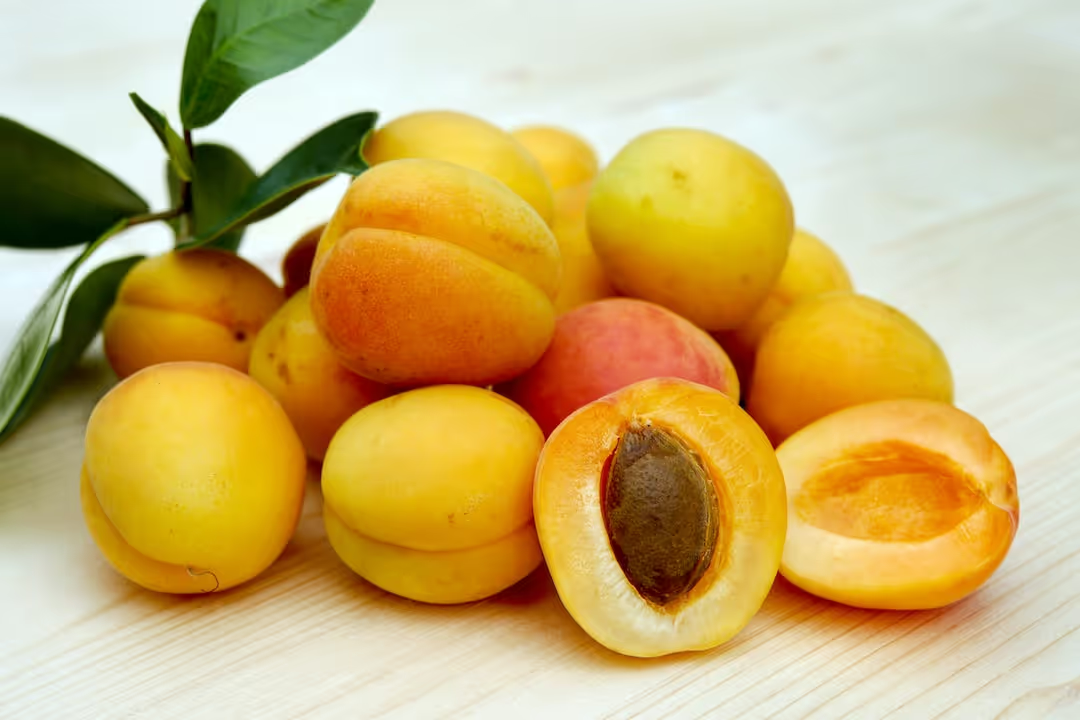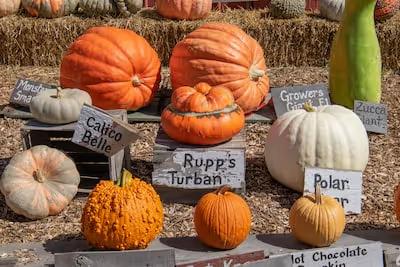Growing Apricot Trees for a Healthy and Abundant Harvest

Growing Apricot
Growing apricot trees rewards patience with flavorful fruit and vibrant blossoms. Choose a sunny, sheltered spot with well-drained soil to give your apricot sapling a strong start. Prune annually during dormancy to promote air circulation and abundant harvests—read on to cultivate luscious apricots right outside your door.
Cheatsheet: Apricot Tree Growing Made Simple
🌞 Ideal Planting Conditions
- Full sun (min. 6 hrs/day)
- Well-drained, sandy-loam soil pH 6.5–8
- Zones: USDA 5–8 (tolerates -20°F / -28°C)
- Plant late winter or early spring
🌱 Varieties to Try
- Blenheim: flavor, productive
- Moorpark: cold-hardy
- Tilton: disease-resistant
- Goldcot: frosty climates
🔧 Tools and Products You'll Need
- Apricot sapling or grafted tree
- Pruning shears & saw
- Compost or organic fertilizer
- Watering can or hose
- Mulch (straw, bark)
- Tree guard or netting (pest protection)
⚒️ Planting Steps
- Dig hole: 2x root ball width, depth equal to root ball.
- Mix compost into soil. Place tree; roots spread.
- Backfill. Water in thoroughly.
- Mulch 2–3 in (5–8 cm) thick, keep from trunk.
- Stake only if windy. Remove after 1 year.
💧 Watering & Feeding
- Water deeply 1x/week (more in heat, less in rain)
- Reduce water in fall for winter dormancy
- Spring: apply balanced organic fertilizer
✂️ Pruning & Care
- Prune late winter for shape & airflow
- Remove dead, crossing, or vertical shoots
- Thin fruit to 4 in (10 cm) spacing for size
- Protect blooms with frost cloth if late frost threatens
🐞 Common Pests & Solutions
- Net trees to deter birds & squirrels
- Spray neem oil for aphids, mites
- Monitor for gummosis (oozing sap): prune infected wood
🍑 Harvest & Storage
- Harvest firm but fragrant fruit, late spring–mid-summer
- Chill up to 2 weeks or dry for longer storage
- One tree yields up to 30–100 lbs (13–45 kg)/year at maturity
🌿 Health & Self-Sufficiency
- Rich in vitamin A, C, potassium, fiber
- No chemicals—eat fresh, dry, jam, or freeze
- Supports pollinators early in season
-
Growing Apricot: climate, chill, and site
I plan for frost first because apricot flowers are fearless and early. They pop, then one cold snap writes the ending.
Most cultivars need 300 to 700 chill hours between 32 to 45 F, 0 to 7 C, and a dry spring to finish cleanly. I’ve had reliable crops in USDA Zones 6 to 9 with air drainage and sun from dawn to mid afternoon.
“Apricot blossoms at full bloom can be badly damaged around 26 F, minus 3 C.” Washington State University Extension
Pick a south or southeast slope if you can. That aspect warms steadily yet avoids the late afternoon scorch that bakes fruit skins.
Soil matters more than bravado. Plant in well drained loam with pH 6.0 to 7.5, and never in a swale that stays wet after rain.
Varieties and rootstocks that earn their keep
I grow cultivars in two buckets, low chill for warm winters and mid chill for classic temperate zones. I also match the tree to a rootstock that fits my soil.
- Blenheim, Royal: about 350 to 450 chill hours, self fertile, honeyed flavor, thin skin that bruises if you look at it wrong.
- Harcot, Harglow: around 700 chill hours, good cold hardiness, better disease tolerance, firm texture.
- Goldcot: roughly 700 to 800 chill hours, late bloom for less frost risk, excellent for canning and jam.
- Katy: near 250 to 400 chill hours, early and heavy, needs thinning to avoid limb breakage.
- Mormon, Chinese (Prunus mume hybrid types vary): cold tough selections for edgy sites, check local trials.
Rootstock picks I trust: Myrobalan plum or Marianna 2624 for heavier or wetter soils, Lovell or Nemaguard for sandy, well drained sites, and Citation for compact growth in small yards. Ask the nursery for proven combinations in your region.
“Most apricot cultivars are self fruitful, yet a second compatible tree can improve fruit set in marginal weather.” University of California Agriculture and Natural Resources
Planting done right
Set bare root trees late winter while dormant, or container trees in early spring as soils warm. Space standards 15 to 20 feet, 4.5 to 6 m, and dwarfs 8 to 12 feet, 2.5 to 3.5 m.
Keep the graft union 2 to 3 inches, 5 to 8 cm, above grade. I water in with 2 to 3 buckets, 20 to 30 liters, then mulch a wide ring, leaving a hand’s width bare around the trunk.
Soil, water, and nutrition
I feed the soil, not the tree. A spring topdress of compost, plus a light nitrogen nudge only if shoot growth is under 12 inches, 30 cm, keeps vigor steady without gummosis flare ups.
Deep water beats frequent sips. In dry heat, I give a young tree 10 to 15 gallons, 38 to 57 liters, once a week, and double that for mature trees during fruit swell.
Avoid soggy roots at all costs. If you see standing water after irrigation, shorten run time and improve drainage.
Training and pruning for light and air
I train apricot to a three to four leader open center because sun ripens flavor and air dries blossoms after spring showers. Choose scaffolds at 24 to 30 inches, 60 to 75 cm, and keep their angles wide with spreaders.
Prune in late summer during dry weather. UC advisors preach this timing to limit bacterial canker, and the difference shows in clean cuts that seal.
- Year 1: head at knee height, then select 3 to 4 evenly spaced shoots.
- Years 2 to 3: shorten scaffolds by one third and remove uprights that shade the interior.
- Mature trees: thin for light, reduce height to a workable ladder reach, and renew fruiting wood.
Bloom, pollination, and thinning
Bees carry the show, so I skip insecticides near bloom and plant flowering understory that peaks earlier or later than apricot. Cold morning during bloom kills set more quietly than a hard frost ever will.
Once fruit reaches olive size, I thin to one apricot every 4 to 6 inches, 10 to 15 cm. The remaining fruit size up, and branches stop snapping after wind storms.
Disease and pest playbook, simple and effective
Brown rot loves rain at bloom, so I remove mummies, keep the canopy open, and use organic sulfur or other labeled fungicides at pink bud if the forecast looks wet. Shot hole and bacterial canker calm down with a dry pruning window and a copper spray in true dormancy, per local guidelines.
Pests to scout: aphids, scale, peach twig borer, oriental fruit moth. I lean on pheromone traps, horticultural oil at dormancy, and targeted products only when monitoring crosses action thresholds.
“Sanitation, pruning for airflow, and timely monitoring form the backbone of stone fruit IPM.” University of California Statewide IPM Program
Frost and heat management that actually works
I stage frost cloth and set alarms for 33 F, 0.5 C. On marginal nights I run microsprinklers through the freeze, which protects blossoms by releasing heat as water turns to ice.
In hot valleys, I whitewash trunks with interior latex paint cut 1 to 1 with water to stop sunburn and borers. Afternoon shade from a light open fence or a nearby deciduous tree can save skins during heat spikes above 100 F, 38 C.
Harvest, ripeness, and storage
Flavor peaks on the tree. Pick when the background shifts from green to deep gold, the fruit gives slightly at the shoulder, and it perfumes your hands.
Handle like eggs. Chill promptly at about 32 F, 0 C, with high humidity, and eat within a week, or dry slices at 125 F, 52 C, for pantry gold.
“A mature apricot tree can yield 50 to 100 pounds, 23 to 45 kg, in a good year with proper thinning.” Colorado State University Extension
Troubleshooting quick hits
- Gumming on trunk: drought stress or canker, water deeply, prune only in dry weather, sanitize tools.
- Lots of flowers, few fruit: cold bloom mornings or poor pollinator activity, add a second cultivar and boost bee forage.
- Leaves with purple spots and holes: shot hole, remove infected leaves, consider a labeled dormant copper spray.
- Fruit drops early: drought or overcrowding, thin earlier and adjust irrigation.
- Spur dieback: shade or borer injury, open the canopy and inspect under bark for larvae.
Buying guide: gear and trees I trust for Growing Apricot
- Best all round cultivar, Mediterranean climates: Blenheim on Myrobalan or Marianna 2624, flavor first, steady set.
- Colder sites: Harcot or Goldcot on Lovell, later bloom, firmer fruit.
- Small yards: Compact selections on Citation, easy height control.
- Frost protection: 1.5 to 2 oz, 50 to 68 g, frost cloth, wide enough to reach the ground and trap radiant heat.
- Spray program basics: dormant oil, a labeled copper for shot hole in dormancy, and sulfur for wet bloom windows.
- Pruning kit: bypass hand pruners, orchard saw with a pull stroke, and a pole pruner you trust on a ladder.
- Monitoring: degree day app or chart for peach twig borer and fruit moth, plus pheromone traps to verify flight.
- Soil test: annual pH and nutrients check to keep nitrogen and potassium in the sweet spot.
Companions and orchard ecology
I underseed with white clover and a spring wildflower mix. It feeds pollinators, suppresses dust that carries spores, and fixes nitrogen that apricot can sip slowly.
Keep trunks mulch free and low limbs pruned so groundcover never rubs bark. That small gap deters voles and keeps cambium clean.
My calendar for Growing Apricot
- Late winter: plant bare root, apply dormant copper and oil if needed, paint trunks, set pheromone traps.
- Early spring: watch chill accumulation and bloom forecast, stage frost cloth, thin at olive size.
- Late spring: dial irrigation for steady soil moisture, scout for twig borer strikes, remove mummies.
- Summer: harvest in waves, summer prune for light after pick, keep water deep and infrequent.
- Autumn: leaf cleanup, soil test, compost topdress, repair basins before winter rain.
Field notes and hard earned tricks
Apricot hates wet feet more than peach and bruises faster than plum. I pick into shallow trays, never buckets, and I cool the crop in the shade before moving it indoors.
On my windiest block, a single additional scaffold kept low at 18 inches, 45 cm, carried a surprising share of fruit and never snapped. Low wood weathers storms better and makes pruning ladders feel optional.
Royal Horticultural Society: “Train for sunlight, prune for airflow, and you grow cleaner fruit with fewer sprays.”
For me, that sums up Growing Apricot. Keep it sunny, keep it dry, and let the tree breathe.
Frequently Asked Questions about Growing Apricot
What soil conditions support healthy apricot growth?
The ideal soil for apricot trees has well-draining properties and a neutral to slightly alkaline pH (around 6.5–7.5). Improve heavy or clay-rich soils by incorporating organic matter, such as compost, to enhance drainage and aeration.
What climate conditions do apricot trees prefer?
Apricot trees thrive in climates experiencing cold winters (temperatures around 32°F/0°C or below for a few weeks) and warm, moderately dry summers between 68°F-86°F (20°C-30°C). Late spring frosts pose a risk to blossoms, so select a planting location with minimal frost exposure.
How often should apricot trees be watered?
Young apricot trees require regular watering once per week, keeping soil consistently moist but well-drained. Mature trees benefit from deep watering every two to three weeks, especially during dry spells, applying water evenly beneath the canopy.
When is the best time to prune apricot trees?
The optimal pruning period for apricot trees is late winter or early spring, before new growth emerges. Prune selectively to remove crossing branches and promote an open canopy structure that enhances air circulation and sunlight exposure.
How long do apricot trees take to bear fruit?
Apricot trees typically begin producing fruit within three to four years after planting. Varieties, growing conditions, and appropriate care can influence fruit production timing.
What pests and diseases affect apricot trees?
Common apricot pests include aphids, borers, and scale insects, while typical diseases encompass bacterial canker, brown rot, and powdery mildew. Regular inspection, proper pruning, and timely application of organic or chemical controls help maintain healthy apricot growth.
Do apricot trees need fertilizer, and if so, what kind?
Feed apricot trees annually in early spring with a balanced fertilizer formulated for fruit trees, such as one containing equal parts nitrogen, phosphorus, and potassium (e.g., 10-10-10). Organic compost or manure can also supplement nutrients effectively, improving overall soil fertility.
Can apricot trees be grown in containers?
Yes, dwarf apricot varieties can flourish in containers. Select large, sturdy pots (at least 20 inches or 50 cm in diameter), using high-quality potting mix with excellent drainage. Ensure regular watering and careful fertilizing, as container-grown apricot trees typically need more frequent monitoring.
Growing Apricot isn’t about chasing perfection—it’s about patience, grit, and knowing your soil as well as your own backyard. Give your tree full sun, honest soil, and a bit of tough love with pruning. Watch for pests, but don’t coddle. Apricots reward the hands that respect their quirks. Water deep, mulch smart, and don’t skip the winter chill. Year after year, you’ll earn fruit that tastes like summer bottled up. If you’re hungry for more homegrown flavor, check out growing loquat for another bold fruit adventure. In the end, growing apricot is simple: plant, care, wait, and savor. The tree will do the rest.
The Homesteader's Sustainable Guide to Apricot Cultivation
Companion Planting for Apricot Health
- Garlic and Onions: Repel pests naturally and improve apricot flavor profiles.
- Borage: Attract bees to enhance pollination by 30-40% and increase fruit yield significantly.
- Chamomile: Boost soil mineral uptake for healthier, disease-resistant apricot trees.
Creating a Self-Sufficient Apricot Harvest Cycle
- Dry Apricots in Sunlight: Spread thinly on mesh racks, dry at temperatures above 95°F (35°C) for 3-4 days for nutrient-rich snacks.
- Apricot Kernel Uses: Roast kernels (10 minutes at 350°F/175°C) to extract nutritious, vitamin E-rich edible oil.
- Leaf Compost Recycling: After autumn leaf-fall, compost leaves to produce potassium-rich mulch to nourish next year's crop.
Natural Pest Control Methods
- Neem Oil Application: Dilute organic neem oil (1 tablespoon per 1 liter water) sprayed weekly reduces aphids, mites, and fungal infections.
- Burlap Tree Bands: Wrap 6-inch (15 cm) wide bands around trunk to trap crawling pests such as caterpillars and earwigs.
Enhancing Apricot Nutritional Benefits
Freeze or preserve fresh-picked apricots within 24 hours to retain maximum vitamin A, vitamin C, and potassium content, optimizing immune health and improving digestive function.
Find out which plants will thrive in your garden!
Answer a few fun questions and get custom plant recommendations perfect for your space. Let’s grow something amazing together!

start your season





